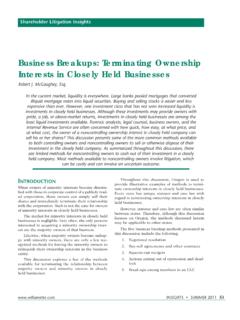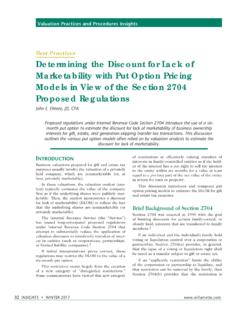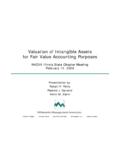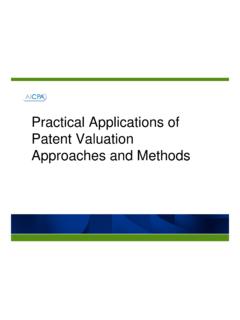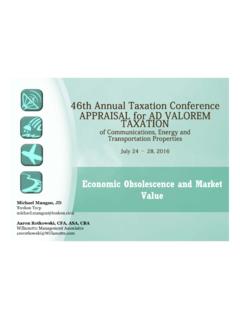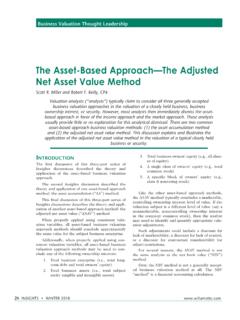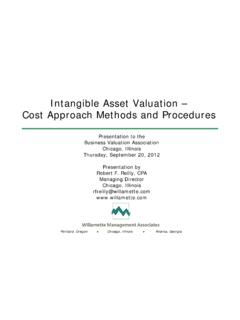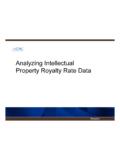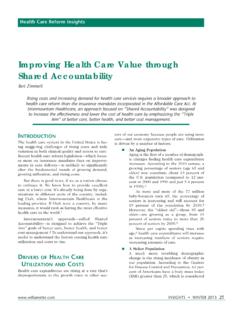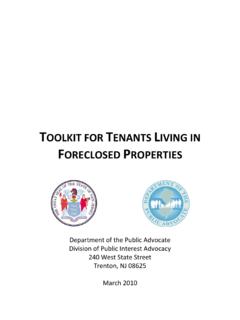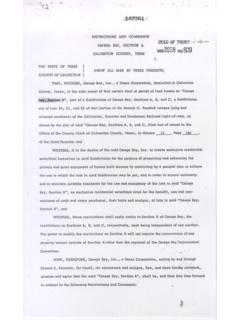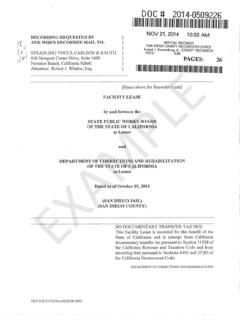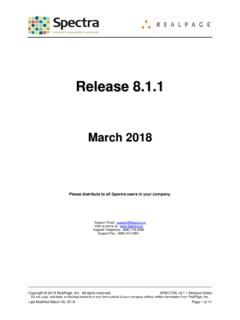Transcription of Income Tax Consequences of Debt Modification
1 72 INSIGHTS AUTUMN 2012 www .willamette .comIncome Tax Consequences of debt ModificationKevin M. Zanni and Robert F. Reilly, CPAB ankruptcy InsightsDebt restructurings are common among financially troubled debtor corporations. And, debt restructurings are common among corporations within bankruptcy protection. However, debt restructurings can have unfavorable Income tax Consequences to the debtor, the creditor, and the third party holding the debt instrument. This discussion summarizes the Income tax Consequences that all parties should consider in a corporate debt restructuring is a common aspect of corporate bankruptcies. debt restructuring is also common to many financially troubled creditors, even if they do not pursue a bankruptcy filing. And, debt restruc-turings may relate to real-estate-related debt , lever-aged buyout debt , and secured or unsecured general corporate discussion summarizes the potential Income tax Consequences to debtors, creditors, and purchas-ers of debt in connection with a debt Modification .
2 A debt Modification may result in the deemed taxable exchange of the old debt instrument for a new debt instrument. The deemed exchange could trigger the recognition of cancellation of debt (COD) deemed exchange could also trigger the fol-lowing:1. To the debtor, the accrual of original issue discount (OID) deductions over the remain-ing debt term2. To the creditor, immediate gain/loss recog-nition and OID incomeInterest limitations may also affect the deduct-ibility of the OID. A two-step analysis is required to determine whether a deemed exchange has first analysis considers: were the terms of the debt modified?The second analysis considers: was the modifica-tion significant? If the Modification was significant, then both the debtor and the creditor should con-sider the associated Income tax one analysIs: has a debt Modification occurred?
3 The term Modification is broadly defined in the Treasury regulations. A Modification typically means any alteration, including any deletion or addition, in whole or in part, of a legal right or obligation of the issuer or debt instrument holder. The alteration can be evidenced by an express agreement (oral or writ-ten), conduct of the parties, or Modification can occur as a result of either of the following activities:1. Amending the debt terms2. Exchanging one debt instrument for anotherThere are three principal exceptions to the defi-nition of a 1: debt Instrument TermsAn alteration of a legal right or obligation that occurs by operation of the debt terms is not a Modification . For example, an annual interest rate resetting based on an interest rate index is not a .willamette .com INSIGHTS AUTUMN 2012 73 However, certain alterations do constitute a Modification , even if the alterations occurs by operation of the debt terms.
4 An example is a change in the nature of the debt , from recourse to non-recourse or vice 2: Failure to PerformThe failure of an issuer to perform its debt obliga-tions is not a Modification . However, while the issuer s nonperformance is not a Modification , the agreement of the holder not to exercise its contrac-tual remedies under the debt instrument may be a 3: Failure to Exercise an OptionIf a party to the debt has an option to change the terms of the instrument, the failure of the party to exercise that option is not a two analysIs: was the debt Modification sIgnIFIcant?Assuming a Modification has occurred, Treasury regulation provides six tests for analyzing whether the debt Modification is significant:1. Facts and circumstances2. Changes in yield3. Changes in payment timing4. Change in obligor or security5.
5 Changes in debt instrument nature6. Change in accounting or financial cov-enantsThe determination of whether the Modification of any debt term is a significant Modification is ana-lyzed under each applicable Facts and CircumstancesUnder this general test, the debt Modification is significant only if, based on all facts and circum-stances, the legal rights or obligations are altered to a degree that is economically making a determination under the facts and circumstances test, all debt modifications should be considered collectively. Therefore, a series of modifications may be significant when considered together although each individual Modification , if considered alone, would not be general test does not apply if there is a specific test that applies to the particular Change in YieldThis test specifically applies to debt that has the fol-lowing attributes:1.
6 Provides for fixed payments only2. Has alternative payment schedules ( , debt subject to contingencies)3. Provides for a fixed yield (such as certain demand loans)4. Has a variable interest rateIf the debt does not fall within one of these four categories, then whether a change in yield is a sig-nificant Modification is determined under the facts and circumstances change in yield is a significant debt modifica-tion if the yield varies from the annual yield on the unmodified debt (determined as of the Modification date) by more than the greater of (1) one-quarter of 1 percent (25 basis points) or (2) 5 percent of the annual yield of the unmodified debt ( x annual yield).A reduction in debt principal reduces the total payments on the modified debt and would result in a reduced yield on the instrument, often resulting in a significant Modification .
7 Therefore, the regula-tions treat a change in debt principal the same as to a change in interest INSIGHTS AUTUMN 2012 www .willamette .com3. Change in Payment TimingIn general, a Modification that changes the timing of the debt payments is a significant Modification if it results in the material deferral of scheduled pay-ments. Examples include an extension of the final maturity date or a deferral of payments due prior to maturity (such as a deferral of interest payments).To assess this exception test, the considerations include the following:1. The length of the deferral2. The original debt term3. The amounts of the payments deferred4. The time period between the Modification and the actual deferral of paymentsThe regulations provide a safe harbor that the debt Modification will not be significant if the deferred payments are required to be paid within the lesser of (1) five years or (2) one-half the origi-nal term of the purposes of this safe harbor, the debt term is determined without regard to any option to extend the original maturity.
8 And, deferrals of de minimis payments are ignored. Deferrals are tested on a cumulative basis so that when payments are deferred for less than the full safe-harbor period, the unused portion of the period remains for any subsequent Change in Obligor or SecurityThe substitution of a new obligor on nonrecourse debt is not a significant Modification . In contrast, the substitution of a new obligor on recourse debt generally is a significant Modification . There are a few exceptions for substitutions of obligors on recourse debt , including the following:1. The new obligor is an acquiring corporation to which Internal Revenue Code Section 381(a) The new obligor acquires substantially all of the obligor s The change in obligor is a result of either a Section 338 election or the filing of a bank-ruptcy an exception to apply, the change in obligor must not result in either (1) a change in payment expectations or (2)
9 A significant alteration would be a significant debt modi-fication but for the fact that the alteration occurs by operation of the debt change in payment expectations occurs if, as a result of a transaction, there is a substantial enhancement or impairment of the obligor s capac-ity to meet the payment obligations after the modi-fication as compared to before the addition or deletion of a co-obligor on the debt is a significant debt Modification if the addition or deletion of the co-obligor results in a change in payment recourse debt , a Modification that releases, substitutes, adds, or otherwise alters the collateral for, a guarantee on, or other form of credit enhance-ment for, recourse debt is a significant Modification if it results in a change in payment nonrecourse debt , a Modification is a sig-nificant debt Modification if it releases, substitutes, adds, or otherwise alters a substantial amount of the collateral for, a guarantee on, or other form of credit enhancement for, nonrecourse Change in debt Instrument NatureA change in the debt nature from recourse to nonre-course, or vice versa, is a significant debt modifica-tion.
10 There are two exceptions to this , the defeasance of a tax-exempt bond is not a significant debt Modification if the following state-ments apply:1. The defeasance occurs by operation of the terms of the original The issuer places in trust government secu-rities or tax-exempt government bonds that are reasonably expected to provide interest and principal payments sufficient to satisfy the bond payment , a Modification that changes recourse debt to nonrecourse debt is not a significant debt Modification if the following statements apply:1. The debt continues to be secured only by the original The Modification does not result in a change in payment debt Modification that results in an instrument that is not debt for federal Income tax purposes is a significant debt Change in Financial and Accounting CovenantsA Modification is not a significant debt Modification if it adds, deletes, or alters customary accounting or financial.
